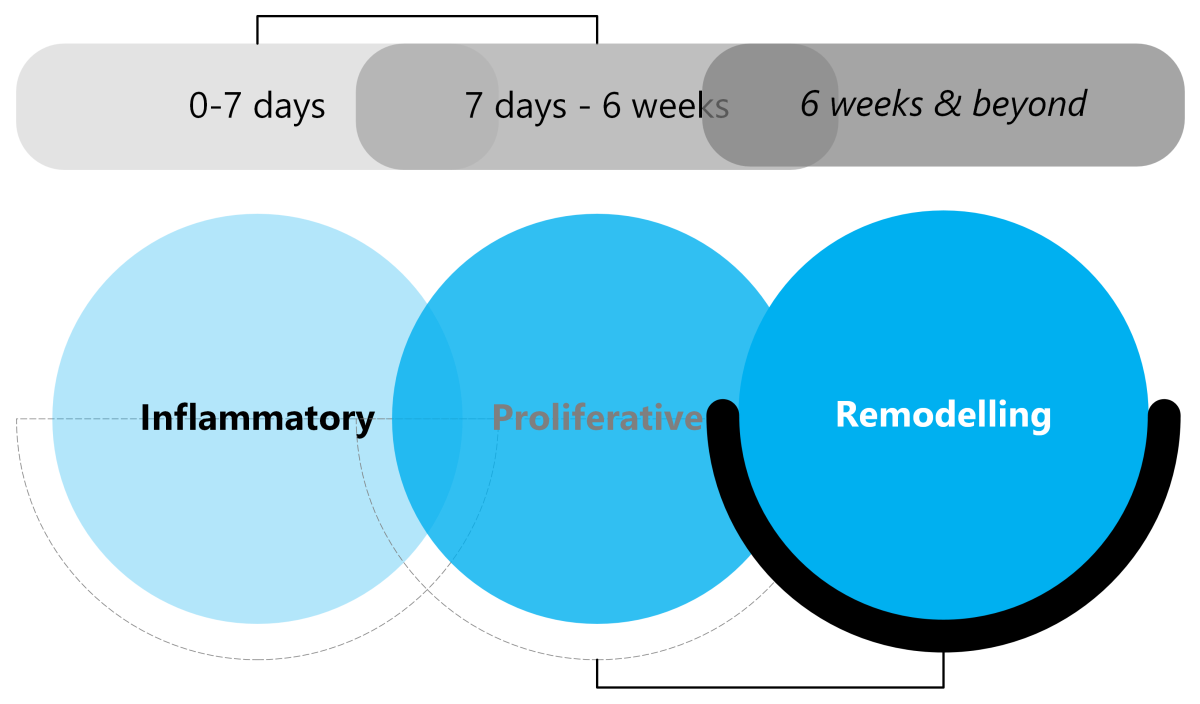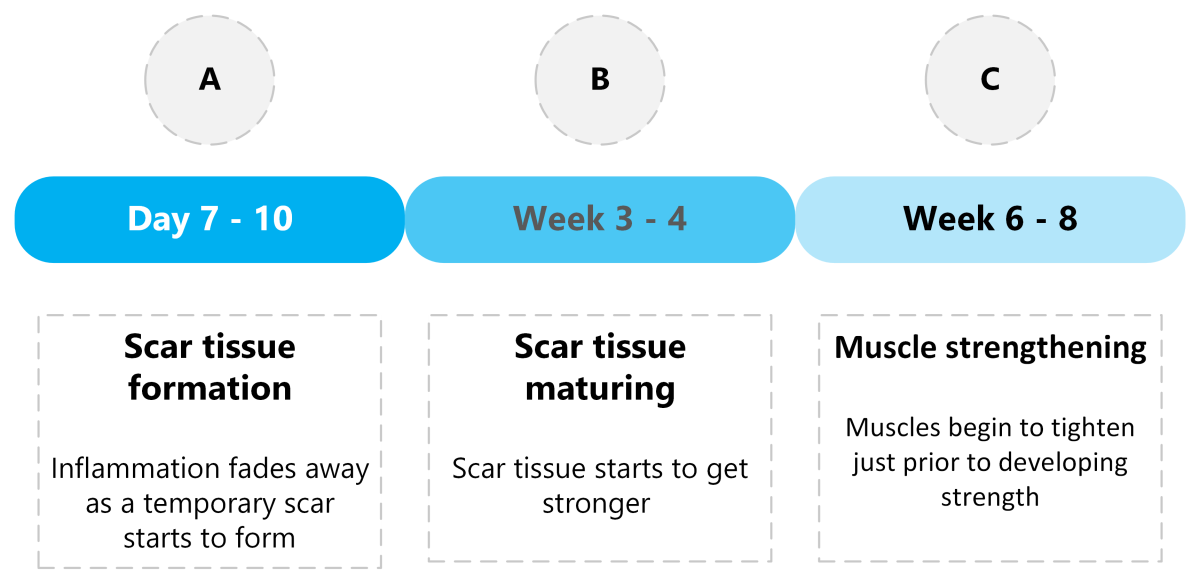Recovery from soft tissue injuries is a complex process, involving distinct phases of healing, each marked by specific biological and physical changes in the body. Throughout this recovery, many people experience a common sensation of tightening around the injured area. This tightening occurs at various stages of the healing process and serves as a critical indicator of the body’s progress. The tightening feeling can be divided into three distinct phases, each corresponding to different aspects of the body’s natural healing cycle. These tightening phases are not just passive experiences but are integral to overall healing, as well as guiding treatment and exercise recommendations.
The Healing Phases: Inflammation, Proliferation, and Remodelling
To understand the role of tightening, it’s important to first appreciate the body’s three main healing phases:

1. Inflammatory Phase (0–7 Days):
This is the body’s initial response to injury, characterised by inflammation, pain, and swelling as the immune system works to clear damaged tissue and initiate repair.
2. Proliferative Phase (7 Days–6 Weeks):
In this phase, the body begins rebuilding the injured tissue by producing new collagen and forming temporary scar tissue. The injured area remains vulnerable but begins to regain strength.
3. Remodelling Phase (6 Weeks–12 Weeks and Beyond):
During this phase, the new tissue is strengthened and reorganised. The body works to restore full function by remodelling the collagen fibres towards stronger more permanent tissue, and increasing strength.
These phases form the foundation of the body’s response to injury. The tightening that patients feel during recovery directly corresponds to critical changes within these phases, signalling key shifts in the healing process. By understanding when and why this tightening occurs, we can better manage the recovery, optimising the outcomes of treatment and exercise. As well as giving a more accurate treatment timing and frequency protocol to follow to maximally accelerate recovery.
Within The Healing Phases: Inflammation, Proliferation, and Remodelling; there also exists:
The Three Phases of Tightening

A. Days 7–10: Scar tissue formation
As the body transitions from the inflammatory phase to the early stages of repair (proliferative phase), people often experience their first significant sensation of tightening. By days 7–10, inflammation has typically dropped right away, and the tissue undergoes early scar tissue formation that can create a sense of stiffness and restriction.
Symptoms start to more obviously improve during this time.
Why Tightening Happens:
- Initial Collagen Formation: Fibroblasts (repair cells) begin producing collagen to replace the damaged tissue. This collagen is laid down in an unorganised manner, contributing to the feeling of tightness as the new tissue forms. The true beginning of scar tissue formation.
- Protective Muscle Spasm: The muscles surrounding the injury tighten protectively to restrict movement and prevent further damage. This muscle guarding often contributes to the tightening sensation during this period.
Importance of This Tightening:
The tightening felt during days 7–10 is an important signal that the body is moving from the acute inflammatory phase into the early stages of repair.
While this tightening can feel uncomfortable, it indicates that healing is underway.
Therapists must carefully manage this stage, introducing gentle, controlled movements to maintain mobility without overstressing the healing tissue. The goal at this point is to promote healing while preventing excessive stiffness, which can delay recovery.
B. Weeks 3–4: Scar tissue maturing
By weeks 3–4, the body is well into the proliferative phase. The early collagen fibres that were laid down in a disorganised manner are now starting to mature and align. This maturation process often brings with it a second wave of tightening, distinct from the initial sensation in the first week.
Symptoms significantly decline during this time.
Why Tightening Happens:
- Collagen Maturation: During this period, type III collagen (the weaker form of collagen) is gradually replaced by stronger, more organised type I collagen. As the collagen fibres mature and align along lines of mechanical stress, the tissue contracts slightly, causing a renewed feeling of tightness.
- Limited Flexibility: The newly formed collagen, while stronger than the initial repair tissue, is not as flexible as the original tissue. It’s stronger, less forgiving, less pliable. This leads to a feeling of stiffness, especially during movement.
- Delayed Onset of Flexibility Work: Flexibility exercises, should be introduced around the two-week mark in most rehabilitation protocols. This helps counteract the feeling of tightness by promoting collagen alignment. Timing is crucial.
Importance of This Tightening:
The tightening experienced during weeks 3–4 is a critical part of the healing process. It indicates that the body is laying down stronger, more resilient tissue. However, this tightening can be restrictive and, if left unmanaged, can lead to excessive scar tissue formation, decreased mobility, and a slower recovery.
During this phase, flexibility exercises become essential in rehabilitation, helping to improve the range of motion and guide the proper alignment of collagen fibres. The goal here is to balance flexibility and strength, preventing the buildup of restrictive scar tissue while allowing the new tissue to strengthen.
C. Weeks 6–8: Muscle Strengthening
As the body enters the remodelling phase (weeks 6–8), the focus shifts from tissue repair to strengthening and functional recovery. During this period, many patients report a third wave of tightening, this time driven by the activation of muscles around the injury site.
Symptoms become minimal during this time. Most soft tissue injuries are at least 80% of original strength at the 6-8 week mark.
All muscles tighten due to strengthening exercise. Coming off a weak base following injury, muscles will overtighten.
With strength exercise
- the exercise is the stimulus,
- the muscle tightens in response
- the muscle is then triggered to grow in size and strength.
Why Tightening Happens:
- Muscle Activation and Strengthening: During this phase, patients are typically introduced to more intensive strengthening exercises in their rehabilitation programs. As the muscles begin to respond to increased load and demand, they tighten as a precursor to building strength.
- Muscle Adaptation: The tightening in this phase is largely due to muscle adaptation. As the muscles surrounding the injury engage more actively, they contract in response to the increased resistance. This tightening is a natural part of the strengthening process, signalling that the body is building the capacity to support normal function.
- Continued Collagen Remodelling: Although the tissue is mostly healed by this point, collagen fibres continue to reorganise and align along lines of stress. This process can contribute to a feeling of stiffness during and after physical activity. Scar tissue continues to shrink and tighten.
Importance of This Tightening:
The muscle tightening experienced during weeks 6–8 is a positive sign that the body is preparing to regain strength and full function. This phase is crucial for preventing future injuries and restoring the injured area to its pre-injury state.
However, this tightening can also be uncomfortable, and patients must be mindful of not overloading the tissue too quickly.
Gradual, progressive loading through strengthening exercises, combined with ongoing mobility, and flexibility work, helps alleviate tightness and promotes muscle adaptation without risking reinjury.
The Importance of Recognising and Managing Tightening Throughout the Healing Process
The tightening sensations that occur during recovery are not random but reflect specific biological processes that are essential to healing. Each wave of tightening serves a purpose, signalling key transitions in the body’s response to injury:
– Day 7–10 Tightening: Reflects the decline of inflammation and the beginning of tissue repair. It is a sign that healing is underway, and while discomfort is normal, it is crucial to begin gentle movements as early as possible to prepare for this phase.
– Week 3–4 Tightening: Marks collagen maturation, a critical stage in tissue repair. Tightness here reflects the realignment and strengthening of the new tissue. Flexibility work is essential to guide proper collagen organisation and prevent restrictive scar tissue.
– Week 6–8 Tightening: Indicates muscle activation and strengthening, a precursor to full functional recovery. Tightness at this stage signals progress, but proper load management is key to preventing overstress on the still-maturing tissue.
By recognising these tightening phases and addressing them with appropriate treatment and exercise, patients and therapists can optimise recovery, reduce the risk of complications, and ensure that the tissue heals as fully and as quickly as possible.

Graeme Curran. Physiotherapist at PhysioCentral. Miranda.The Sutherland Shire.